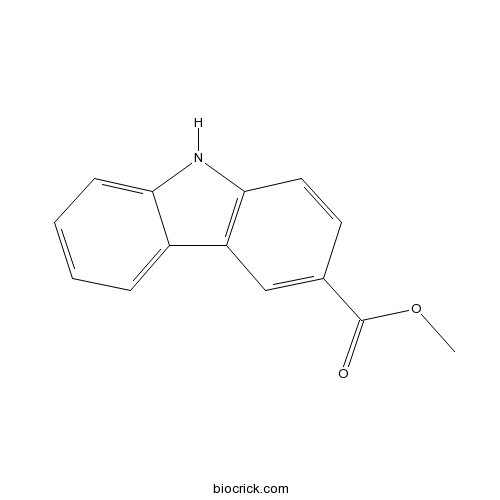Methyl 3-carbazolecarboxylateCAS# 97931-41-4 |

Quality Control & MSDS
3D structure
Package In Stock
Number of papers citing our products

| Cas No. | 97931-41-4 | SDF | Download SDF |
| PubChem ID | 504069 | Appearance | Yellow powder |
| Formula | C14H11NO2 | M.Wt | 225.2 |
| Type of Compound | Alkaloids | Storage | Desiccate at -20°C |
| Solubility | Soluble in Chloroform,Dichloromethane,Ethyl Acetate,DMSO,Acetone,etc. | ||
| Chemical Name | methyl 9H-carbazole-3-carboxylate | ||
| SMILES | COC(=O)C1=CC2=C(C=C1)NC3=CC=CC=C32 | ||
| Standard InChIKey | LZXXHWWSVRIDGR-UHFFFAOYSA-N | ||
| Standard InChI | InChI=1S/C14H11NO2/c1-17-14(16)9-6-7-13-11(8-9)10-4-2-3-5-12(10)15-13/h2-8,15H,1H3 | ||
| General tips | For obtaining a higher solubility , please warm the tube at 37 ℃ and shake it in the ultrasonic bath for a while.Stock solution can be stored below -20℃ for several months. We recommend that you prepare and use the solution on the same day. However, if the test schedule requires, the stock solutions can be prepared in advance, and the stock solution must be sealed and stored below -20℃. In general, the stock solution can be kept for several months. Before use, we recommend that you leave the vial at room temperature for at least an hour before opening it. |
||
| About Packaging | 1. The packaging of the product may be reversed during transportation, cause the high purity compounds to adhere to the neck or cap of the vial.Take the vail out of its packaging and shake gently until the compounds fall to the bottom of the vial. 2. For liquid products, please centrifuge at 500xg to gather the liquid to the bottom of the vial. 3. Try to avoid loss or contamination during the experiment. |
||
| Shipping Condition | Packaging according to customer requirements(5mg, 10mg, 20mg and more). Ship via FedEx, DHL, UPS, EMS or other couriers with RT, or blue ice upon request. | ||
| Targets | Immunology & Inflammation related |

Methyl 3-carbazolecarboxylate Dilution Calculator

Methyl 3-carbazolecarboxylate Molarity Calculator
| 1 mg | 5 mg | 10 mg | 20 mg | 25 mg | |
| 1 mM | 4.4405 mL | 22.2025 mL | 44.405 mL | 88.8099 mL | 111.0124 mL |
| 5 mM | 0.8881 mL | 4.4405 mL | 8.881 mL | 17.762 mL | 22.2025 mL |
| 10 mM | 0.444 mL | 2.2202 mL | 4.4405 mL | 8.881 mL | 11.1012 mL |
| 50 mM | 0.0888 mL | 0.444 mL | 0.8881 mL | 1.7762 mL | 2.2202 mL |
| 100 mM | 0.0444 mL | 0.222 mL | 0.444 mL | 0.8881 mL | 1.1101 mL |
| * Note: If you are in the process of experiment, it's necessary to make the dilution ratios of the samples. The dilution data above is only for reference. Normally, it's can get a better solubility within lower of Concentrations. | |||||

Calcutta University

University of Minnesota

University of Maryland School of Medicine

University of Illinois at Chicago

The Ohio State University

University of Zurich

Harvard University

Colorado State University

Auburn University

Yale University

Worcester Polytechnic Institute

Washington State University

Stanford University

University of Leipzig

Universidade da Beira Interior

The Institute of Cancer Research

Heidelberg University

University of Amsterdam

University of Auckland

TsingHua University

The University of Michigan

Miami University

DRURY University

Jilin University

Fudan University

Wuhan University

Sun Yat-sen University

Universite de Paris

Deemed University

Auckland University

The University of Tokyo

Korea University
- 3,4'-Dihydroxy-3,5',7-trimethoxyflavan
Catalog No.:BCN4528
CAS No.:97914-19-7
- Estradiol valerate
Catalog No.:BCC4482
CAS No.:979-32-8
- Norfloxacin lactate
Catalog No.:BCC9104
CAS No.:97867-34-0
- 8,9-Didehydro-7-hydroxydolichodial
Catalog No.:BCN6674
CAS No.:97856-19-4
- Penciclovir Sodium
Catalog No.:BCC5635
CAS No.:97845-62-0
- IMD 0354
Catalog No.:BCC4556
CAS No.:978-62-1
- Lappaconitine Hydrobromide
Catalog No.:BCN2505
CAS No.:97792-45-5
- Jasmoside
Catalog No.:BCN7552
CAS No.:97763-17-2
- 2,6-Dimethyl-3-O-methyl-4-(2-methylbutyryl)phloroglucinol
Catalog No.:BCN7356
CAS No.:97761-91-6
- 2,6-Dimethyl-3-O-methyl-4-isobutyrylphloroglucinol
Catalog No.:BCN7355
CAS No.:97761-90-5
- S186
Catalog No.:BCC5285
CAS No.:97759-16-5
- Chuanxiongzine hydrochloride
Catalog No.:BCC8147
CAS No.:97747-88-1
- Sophoraflavanone G
Catalog No.:BCN2987
CAS No.:97938-30-2
- Leachianone A
Catalog No.:BCN4530
CAS No.:97938-31-3
- Methyl (E)-3'-hydroxy-4'-methoxycinnamate
Catalog No.:BCN1294
CAS No.:97966-29-5
- Benzenesulfonic acid
Catalog No.:BCC8846
CAS No.:98-11-3
- 4-Aminophenylarsonic acid
Catalog No.:BCC8688
CAS No.:98-50-0
- Terpineol
Catalog No.:BCN3595
CAS No.:98-55-5
- H-Pyr-OH
Catalog No.:BCC3328
CAS No.:98-79-3
- Acetophenone
Catalog No.:BCN8300
CAS No.:98-86-2
- Nicotinamide
Catalog No.:BCN1025
CAS No.:98-92-0
- Pyrazinamide
Catalog No.:BCC4932
CAS No.:98-96-4
- Brompheniramine hydrogen maleate
Catalog No.:BCC4515
CAS No.:980-71-2
- Lomefloxacin HCl
Catalog No.:BCC4673
CAS No.:98079-52-8
Anti-tuberculosis constituents from the stem bark of Micromelum hirsutum.[Pubmed:15770548]
Planta Med. 2005 Mar;71(3):261-7.
Anti-TB bioassay-directed fractionation led to the isolation of six carbazole alkaloids, as well as the gamma-lactone derivative of oleic acid, from the CH (2)Cl (2) extract of the stem bark of Micromelum hirsutum. The carbazoles include the new micromeline ( 2) and five known alkaloids: lansine ( 3), 3-methylcarbazole ( 4), methyl carbazole-3-carboxylate ( 5), 3-formylcarbazole ( 6), and 3-formyl-6-methoxycarbazole ( 7). Compound 1 was identified as the lactone derivative of oleic acid, (-)- Z-9-octadecene-4-olide, for which the trivial name micromolide ( 1) is suggested. It showed potent in vitro anti-TB activity against H37R v (MIC: 1.5 microg/mL), a selectivity index (SI) of 63, and exhibited activity against the Erdman strain of M. tuberculosis in a J774 mouse macrophage model (EC (90) : 5.6 microg/mL). Thus, 1 appears worthy of further evaluation as a potential new anti-TB agent. Isolates 2, 3, 6 and 7 had anti-TB MIC values between 14.3 and 42.3 microg/mL, while compounds 4 and 5 were considered inactive (MIC > 128 microg/mL). Structure elucidation and identification were based on spectroscopic analysis, including MS, 1D/2D NMR, and a full (1)H spin system analysis of 1.


